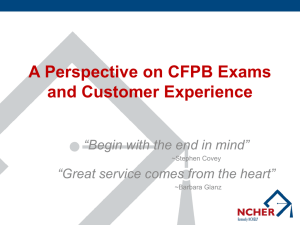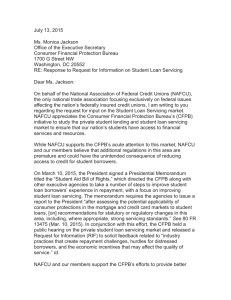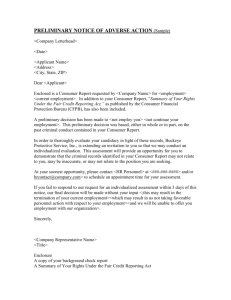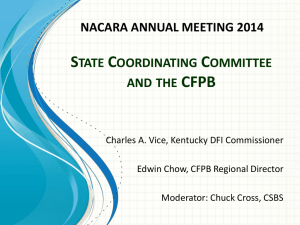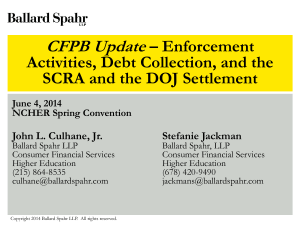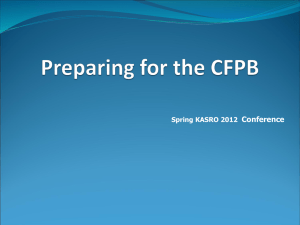The Consumer Financial Protection Bureau: Designed to Fail?
advertisement
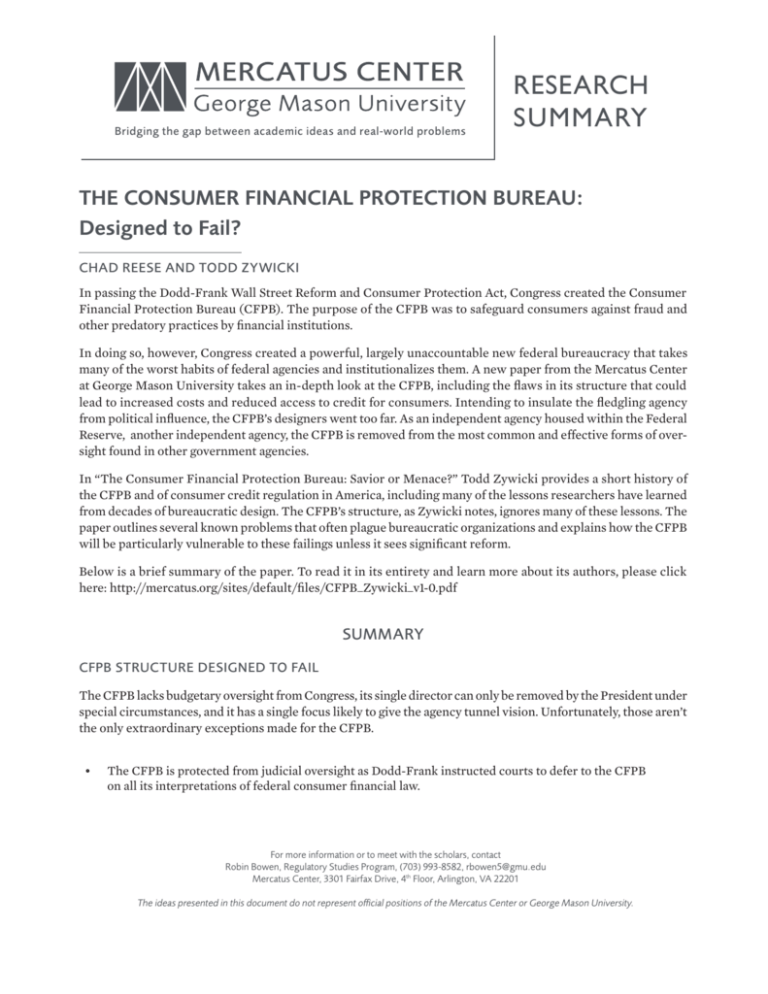
Bridging the gap between academic ideas and real-world problems RESEARCH SUMMARY THE CONSUMER FINANCIAL PROTECTION BUREAU: Designed to Fail? CHAD REESE AND TODD ZYWICKI In passing the Dodd-Frank Wall Street Reform and Consumer Protection Act, Congress created the Consumer Financial Protection Bureau (CFPB). The purpose of the CFPB was to safeguard consumers against fraud and other predatory practices by financial institutions. In doing so, however, Congress created a powerful, largely unaccountable new federal bureaucracy that takes many of the worst habits of federal agencies and institutionalizes them. A new paper from the Mercatus Center at George Mason University takes an in-depth look at the CFPB, including the flaws in its structure that could lead to increased costs and reduced access to credit for consumers. Intending to insulate the fledgling agency from political influence, the CFPB’s designers went too far. As an independent agency housed within the Federal Reserve, another independent agency, the CFPB is removed from the most common and effective forms of oversight found in other government agencies. In “The Consumer Financial Protection Bureau: Savior or Menace?” Todd Zywicki provides a short history of the CFPB and of consumer credit regulation in America, including many of the lessons researchers have learned from decades of bureaucratic design. The CFPB’s structure, as Zywicki notes, ignores many of these lessons. The paper outlines several known problems that often plague bureaucratic organizations and explains how the CFPB will be particularly vulnerable to these failings unless it sees significant reform. Below is a brief summary of the paper. To read it in its entirety and learn more about its authors, please click here: http://mercatus.org/sites/default/files/CFPB_Zywicki_v1-0.pdf SUMMARY CFPB STRUCTURE DESIGNED TO FAIL The CFPB lacks budgetary oversight from Congress, its single director can only be removed by the President under special circumstances, and it has a single focus likely to give the agency tunnel vision. Unfortunately, those aren’t the only extraordinary exceptions made for the CFPB. • The CFPB is protected from judicial oversight as Dodd-Frank instructed courts to defer to the CFPB on all its interpretations of federal consumer financial law. For more information or to meet with the scholars, contact Robin Bowen, Regulatory Studies Program, (703) 993-8582, rbowen5@gmu.edu Mercatus Center, 3301 Fairfax Drive, 4th Floor, Arlington, VA 22201 The ideas presented in this document do not represent official positions of the Mercatus Center or George Mason University. • If the Financial Stability Oversight Council (FSOC) wants to overturn a CFPB rule that it finds threatens the stability of the entire financial sector, it needs a two-thirds majority vote. • The CFPB automatically receives its funding directly from the Federal Reserve. DESIGN IGNORES THE LESSONS OF DECADES OF RESEARCH While the CFPB’s structure is unusual by today’s standards, it closely resembles the antiquated agency design of the New Deal era that led to the bureaucratic dysfunction of the Nixon administration. The reforms employed when agencies were modernized under Jimmy Carter and Ronald Reagan are largely absent in the CFPB’s design. Because the CFPB is largely unaccountable and retains a single-issue focus on “consumer protection,” it is likely to develop tunnel vision and make consumers worse off. • A single-issue focus will make the CFPB blind to the unintended consequences of its rules, particularly for other sectors of the economy. • Like many bureaucratic agencies, the CFPB is unlikely to properly judge the benefits to the consumer from competition, choice, and innovation. • We can expect CFPB directors to prefer short-term regulatory activity over long-term increases in cost and reductions in availability of credit. Short-term actions let current officials enjoy the benefits of rulemaking or enforcement actions while passing off long-term costs to future agency officials. • The CFPB is susceptible to agency capture, namely from the largest banks who will be able to shoulder the significant compliance costs of new rules. That puts smaller community banks with fewer resources at risk of closing down or offering fewer services to their clients. AN EXAGGERATED FOCUS ON SIMPLICITY In part because of the agency’s single-issue focus, it wrongly stresses simplicity as a core solution to consumer financial concerns. Complexity is sometimes good and sometimes bad, but understanding what makes a product complex is important. • Despite a concern that consumer financial products are overly complex, we should realize that most consumer products, e.g., cars or computers, are extremely complex. • Complexity is not an indication of fraud, but rather an indication that the credit needs of consumers are becoming more complex. • Much of the complexity in credit markets is not even the fault of companies. It has been created through decades of litigation and regulation. SUGGESTED SOLUTIONS With the CFPB and other attempts to regulate consumer finance, the federal government continues to drive consumers out of the mainstream financial system. If this trend is to be reversed, the CFPB’s structure must be reformed to avoid the well-known pitfalls of bureaucratic agencies. MERCATUS CENTER AT GEORGE MASON UNIVERSITY 2 • Replace the single director of the CFPB with a deliberative commission like those of other independent agencies. • Permit Congress to exercise budgetary oversight of the CFPB. • Give the CFPB a dual-focus, like the Federal Trade Commission, to avoid tunnel vision and require it to consider the consumer benefits of a competitive market. • The goal of the CFPB should be to reach an optimal level of simplicity, not a maximum level. ABOUT THE AUTHORS Todd Zywicki is a senior scholar at the Mercatus Center and a George Mason University Foundation Professor of Law at George Mason University School of Law. His primary research interests are consumer credit regulation, bankruptcy, credit cards, and mortgages. Chad Reese is an outreach associate at the Mercatus Center at George Mason University. ABOUT THE MERCATUS CENTER The Mercatus Center at George Mason University is the world’s premier university source for market-oriented ideas—bridging the gap between academic ideas and real-world problems. A university-based research center, Mercatus advances knowledge about how markets work to improve people’s lives by training graduate students, conducting research, and applying economics to offer solutions to society’s most pressing problems. Our mission is to generate knowledge and understanding of the institutions that overcome the barriers preventing individuals from living free, prosperous, and peaceful lives. Founded in 1980, the Mercatus Center is located on George Mason University’s Arlington campus. www.mercatus.org MERCATUS CENTER AT GEORGE MASON UNIVERSITY 3

